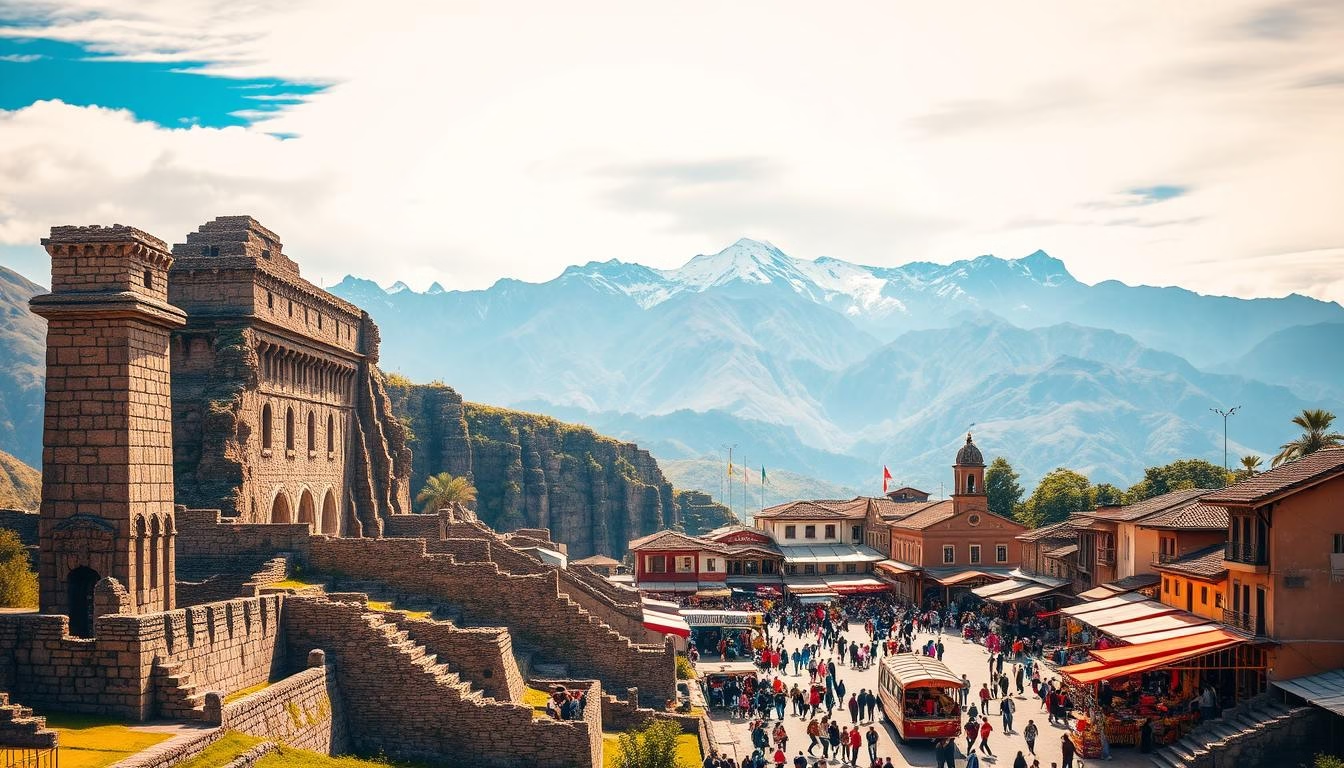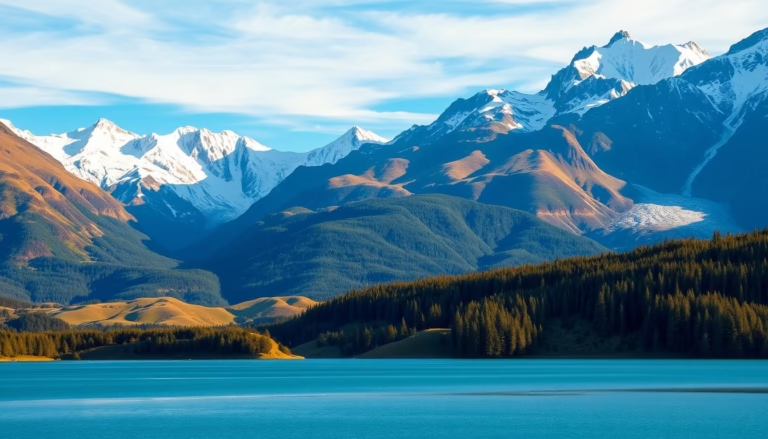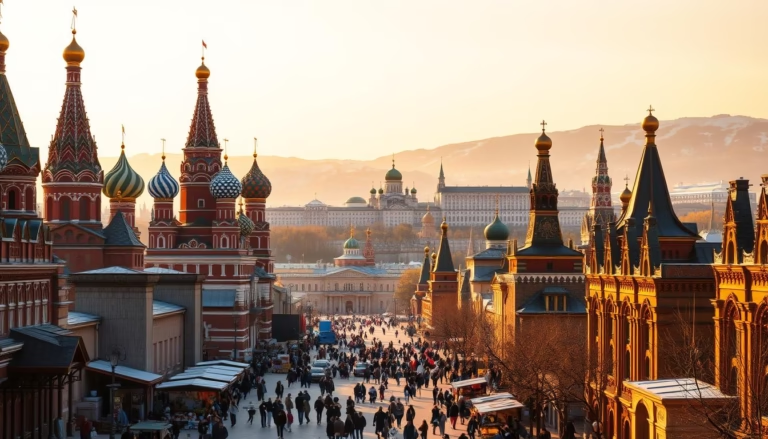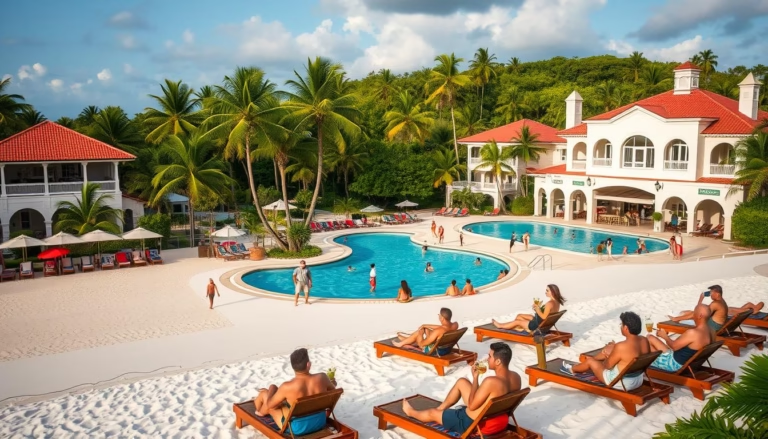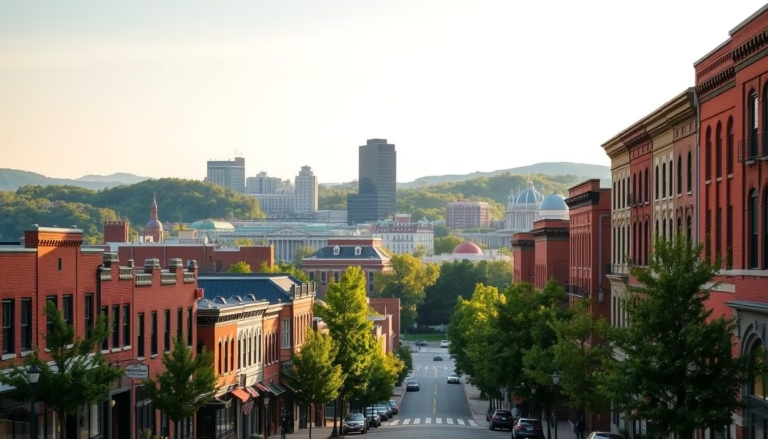Best Cities to Visit in Peru: Explore the Culture and History
Did you know Peru’s land area could swallow Texas twice and still have room for Italy? This South American giant packs more geographic diversity than 90% of countries worldwide, from coastal deserts to cloud forests and snow-capped peaks.
Travelers find endless surprises here. You’ll stumble upon colonial-era architecture in bustling urban centers, then hours later walk sacred paths carved by Inca engineers. The country’s cultural tapestry blends indigenous traditions with Spanish influences, creating vibrant festivals and mouthwatering cuisine.
What makes these destinations truly special? Each location tells part of Peru’s epic story. Coastal hubs buzz with modern energy while highland towns preserve ancient ways of life. You might explore 15th-century ruins at sunrise and savor award-winning restaurants by sunset.
Key Takeaways
- Peru’s massive size creates distinct regional cultures and ecosystems
- Urban centers blend ancient history with contemporary comforts
- Dramatic landscapes range from arid coasts to Amazon rainforests
- UNESCO sites and living traditions coexist in many locations
- Accessible transportation connects diverse destinations
- Local cuisine reflects cultural fusion across regions
This guide reveals how to experience Peru’s soul through its most captivating places. We’ll navigate cobblestone streets lined with Spanish balconies, hike to archaeological marvels, and uncover hidden spots most visitors miss. Get ready to craft your perfect itinerary where every turn reveals new wonders.
Introduction
From the Amazon’s emerald canopy to the Andes’ icy ridges, this South American nation delivers unmatched variety. Three radical landscapes – arid coastlines, mountain ranges, and rainforests – create micro-worlds teeming with unique wildlife. More than just sightseeing, every journey here becomes a crash course in civilizations that shaped continents.
Ancient stories echo through stone temples and woven textiles. The Inca get most attention, but older cultures like the Nazca left desert etchings visible from space. Modern chefs now reinterpret 3,000-year-old recipes using Amazonian ingredients, proving history here breathes through daily life.
| Region | Key Feature | Unique Experience |
|---|---|---|
| Coastal Desert | Pre-Columbian pyramids | Sandboarding oasis towns |
| Andes Mountains | Inca trail networks | Condor-spotting at sunrise |
| Amazon Basin | Biodiversity hotspot | Night jungle expeditions |
Locals greet visitors like old friends, sharing traditions from Quechua weaving demos to pisco sour recipes. Whether tracing sacred valleys or tasting fusion ceviche, you’ll collect memories faster than passport stamps. Ready to dive deeper? Let’s explore specific destinations that make this nation extraordinary.
Lima: The Vibrant Capital
Where else can you sip pisco sours atop oceanfront cliffs while 16th-century church bells echo through traffic? Peru’s capital thrives as a living collage where colonial cathedrals share zip codes with sushi bars. Nine million residents power this coastal metropolis, blending Spanish-era grandeur with sleek innovation.
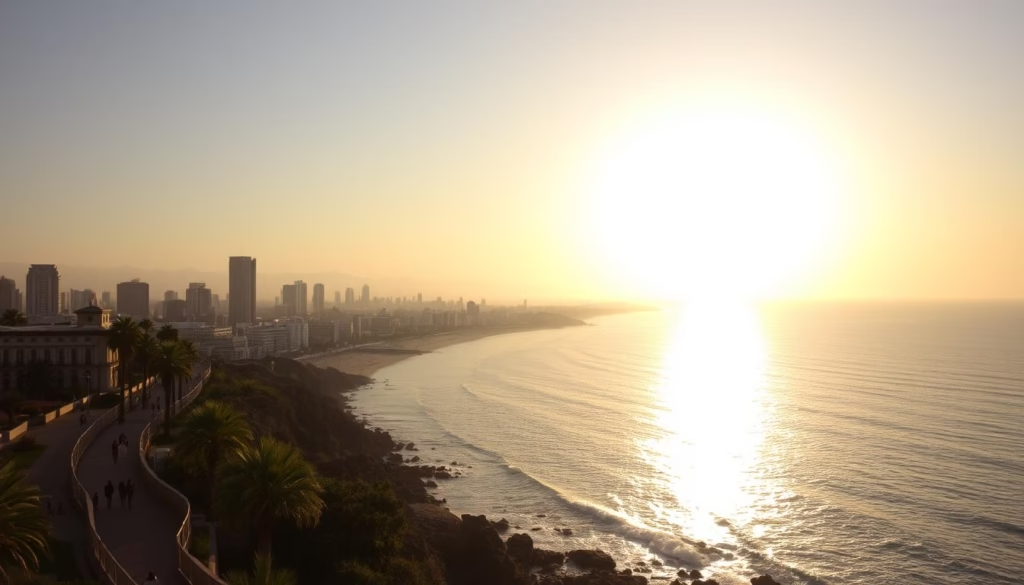
Coastal Charm and Modern Infrastructure
Cliffside neighborhoods like Miraflores dazzle with glass towers overlooking surfers at Playa Makaha. The malecón boardwalk stretches for miles, offering sunset cyclists panoramic ocean views. Barranco’s pastel mansions house boutique hotels, while its iconic Bridge of Sighs connects art galleries to jazz clubs.
Historic Plaza Mayor anchors the UNESCO-listed center. Here, baroque architecture whispers tales of Spanish viceroys. Modern transit systems make crossing the city effortless – from ancient adobe pyramids to the ultimate Lima travel guide’s recommended hidden gems.
Culinary Scene and Cultural Hotspots
Lima’s kitchens rewrite culinary rules daily. Chefs fuse Amazonian fruits with Japanese techniques at world-ranking restaurants. Street vendors counter with anticuchos (skewered hearts) sizzling beside Inca corn.
| Neighborhood | Highlights | Best For |
|---|---|---|
| Miraflores | Cliffside parks, luxury shopping | Ocean views & modern stays |
| Barranco | Art murals, bohemian cafes | Nightlife & local culture |
| Historic Center | Plaza Mayor, San Francisco Catacombs | Architecture & history |
The Museo Larco stuns with gold-filled galleries, its pre-Columbian ceramics spanning millennia. For hands-on travel experiences, local markets like Surquillo burst with lucuma fruit and woven textiles – perfect souvenirs from this coastal crossroads.
Cusco: The Gateway to Incan Culture
Ever stood where empires collided? Cusco’s streets whisper secrets of Inca rulers and Spanish conquistadors. This high-altitude marvel serves as the launchpad for exploring Machu Picchu while dazzling visitors with its own treasures.
Stone Giants Meet Spanish Splendor
Massive Inca walls form the bones of Cusco’s colonial architecture. The 16th-century cathedral on Plaza de Armas sits atop an Inca palace – its gold-leaf altar glowing above ancient foundations. Don’t miss Sacsayhuaman’s zigzagging stone walls, where 300-ton blocks fit like puzzle pieces.
Living Traditions in Vibrant Markets
At San Pedro Market, rainbow-stacked fruits compete with handwoven textiles. Artisans demonstrate centuries-old dyeing techniques using cochineal insects. Sample chicha morada (purple corn drink) while chatting with Quechua-speaking vendors.
| Attraction | Historical Period | Visitor Experience |
|---|---|---|
| Sacsayhuaman | Inca Empire | Exploring ceremonial stone structures |
| Plaza de Armas | Colonial Era | Cafés facing Baroque cathedrals |
| San Pedro Market | Modern Day | Tasting Andean street food |
| Qorikancha Temple | Inca/Spanish Fusion | Golden courtyard under a convent |
Morning hikes to nearby ruins help acclimate to the 11,152-foot elevation. As the sun sets, Machu Picchu travelers swap stories in courtyard restaurants serving alpaca stew. Every corner here blends history with living culture – no time machine required.
Machu Picchu: The Lost City of the Incas
What ancient marvel leaves engineers scratching their heads centuries later? This 15th-century Inca citadel crowns mountain ridges like a stone crown, its dry-stone walls fused without mortar. Recognized as both a UNESCO World Heritage Site and a New Seven Wonders of the World, it draws explorers to its cloud-forest throne.
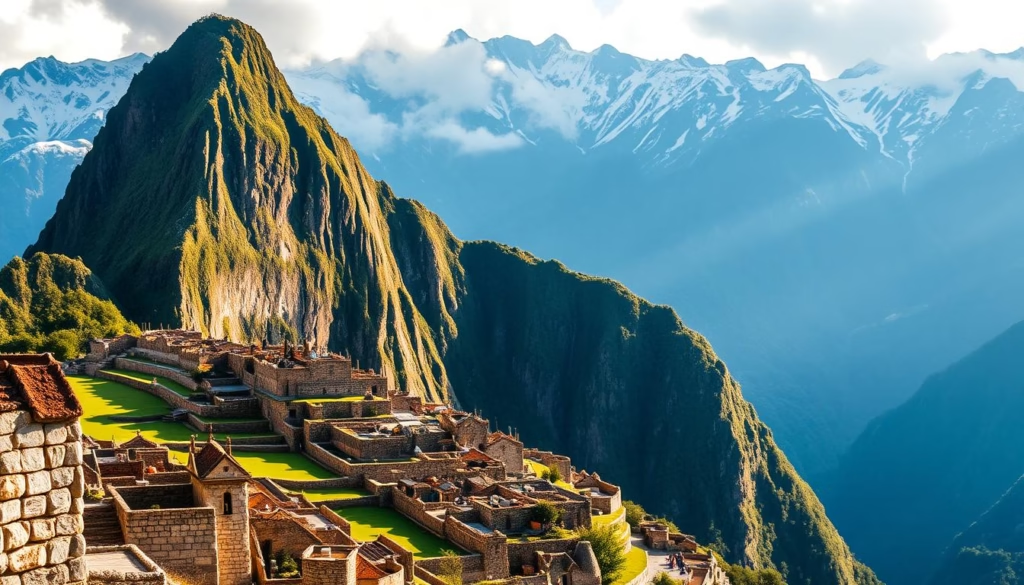
Granite blocks weighing up to 50 tons interlock with laser-like precision. Some theories suggest advanced astronomical alignment, while others marvel at the terraced agriculture systems. For panoramic perspectives, climb Huayna Picchu’s steep stairs or Machu Picchu Mountain’s winding paths.
Trekking Routes and Scenic Overlooks
The classic Inca Trail remains the gold-standard approach. This four-day journey winds through Andean ecosystems, passing lesser-known enigmatic lost cities before the Sun Gate reveal. Time-crunched travelers opt for the two-day trek starting at KM 104.
| Route | Duration | Highlights |
|---|---|---|
| Classic Inca Trail | 4 days | Sunrise at Inti Punku |
| Short Inca Trail | 2 days | Wiñay Wayna ruins |
| Salkantay Trek | 5 days | Glacial mountain views |
Morning mists often cloak the site, creating an ethereal atmosphere. Guides recommend arriving before 10 AM to beat crowds. Remember: tickets for Huayna Picchu and Machu Picchu Mountain sell out months ahead. This protected site limits daily entries, so plan your visit early.
Sacred Valley: Where History Meets Nature
Imagine a place where thousand-year-old farming techniques still shape the landscape. The Sacred Valley breathes life into Inca traditions while cradling some of Peru’s most breathtaking archaeological sites. This fertile corridor along the Urubamba River connects Cusco to Machu Picchu, offering travelers a living museum of Andean heritage.
Farmers in colorful mantas tend to quinoa fields using methods unchanged since Inca times. Artisans in Pisac market demonstrate natural dye techniques passed through generations. The valley’s culture thrives in daily rituals – from potato harvests to weaving ceremonies honoring Pachamama (Mother Earth).
Ancient Sites and Terraced Landscapes
Four standout locations showcase the area‘s engineering genius. Ollantaytambo’s fortress-like terraces guarded the valley, while Moray’s circular depressions served as agricultural laboratories. Local guides often remark:
“These stones hold more stories than history books. Every terrace tells of survival, every ruin whispers innovation.”
| Site | Key Feature | Best Time to Visit |
|---|---|---|
| Pisac Ruins | Terrace network & astronomy platforms | Morning light |
| Ollantaytambo | Sun Temple & warrior statues | Late afternoon |
| Moray | Concentric crop circles | Midday sun |
| Maras Salt Pans | 4,000 mineral-rich pools | Dry season |
Adventure seekers find endless ways to explore. Mountain bike past pre-Columbian aqueducts, or raft the Urubamba’s rapids below Inca suspension bridges. For a deeper experience, stay in Ollantaytambo – its cobblestone streets lead to cozy lodges perfect for multi-day explorations of the valley’s 15 must-see destinations.
The Sacred Valley rewards those who take time to wander. Share a meal with Quechua people in Chinchero, or watch sunset paint Maras’ salt pools gold. Each visit here becomes a conversation across centuries – no translation needed.
Lake Titicaca: A High-Altitude Adventure
Have you ever walked on islands made entirely of reeds? At 12,500 feet above sea level, Lake Titicaca straddles Peru and Bolivia as the world’s highest navigable lake. This shimmering expanse becomes a living classroom where ancient traditions thrive on man-made islands.
Floating Islands and Indigenous Traditions
The Uros people maintain a unique way of life on totora reed islands. They rebuild their floating homes monthly, using techniques unchanged since pre-Inca times. Visitors often marvel at solar-powered boats docked beside traditional reed crafts.
Nearby Taquile Island reveals another layer of local culture. Men knit intricate wool hats while women weave vibrant textiles – skills taught from childhood. Shared meals with families let travelers taste quinoa soup and hear stories in Quechua dialects.
Plan ample time to acclimate to the thin air. Sunrise kayak tours offer peaceful moments to absorb the lake’s magic. For those crafting a first visit Peru itinerary, this place delivers an unforgettable high-altitude experience connecting modern visitors with enduring heritage.
